“The Fruit of the Poisonous Tree”: The ECCC Considers Arguments on Torture Evidence
 Today’s Trial Chamber opening session featured oral arguments on the contentious use of evidence obtained through torture. This evidence could fall under the legal doctrine of “the fruit of the poisonous tree” (that should not be eaten). The issue covers three broad questions:
Today’s Trial Chamber opening session featured oral arguments on the contentious use of evidence obtained through torture. This evidence could fall under the legal doctrine of “the fruit of the poisonous tree” (that should not be eaten). The issue covers three broad questions:
- Can a statement obtained by torture be invoked as evidence?
- If so, to what extent can it be used?
- Who can use it?
Article 15 of the United Nations Convention against Torture is considered jus cogens (a peremptory norm that the Court is bound to follow) and reads:
“Each State Party shall ensure that any statement which is established to have been made as a result of torture shall not be invoked as evidence in any proceedings, except against a person accused of torture as evidence that the statement was made.”
Each of the four parties to Case 002/02 had different interpretations of the material article.
Prosecution
The prosecution advocated that it is consistent with Article 15 that statements obtained through torture can be used to prove the cruelty of the regime and that identifying information in the statement is admissible.
International Co-Prosecutor Nicholas Koumjian used as an example someone who is arrested for stealing a banana and then gets tortured. The relevance of the incident is evidence not for the truth of the matter—it is irrelevant whether the person actually stole the banana – but as evidence that people were tortured for small offenses.
Mr. Koumjian remarked that he “found it offensive” that Nuon Chea was attempting to take statements from people who were electrocuted, beaten and degraded, with some having had their fingernails pulled out, to prove that the regime had enemies that they were right to kill.
“The one party that wants to use torture [as evidence],” emphasized Mr. Koumjiam, “is the very person responsible for the torture that took place.”
“Frankly, we are not very worried that you’re going to allow it,” he added.
Civil Party Co-Lawyers
Marie Guiraud, Civil Party Lead Co-Lawyer, believed that there was a presumption in the Court’s jurisprudence in Case 001 that, when statements obtained through torture are admitted, they can be used as proof that the statements were made but not for the truth of the matter.
Judge Lavergne thought that this presumption would switch the burden of the proof of whether a statement was obtained through torture from the prosecution to the defense. He also pointed out that res judicata (“a matter already judged”), does not apply because Case 001 had different defendants.
The Civil Party and prosecution counsel had a similar solution. To wit: that there should be a separate document review hearing when a party wants to use the substance of a document obtained through torture.
In a self-declared “uncommon” divergence of opinion, Nuon Chea and Khieu Samphan’s defense teams had vastly different views on the interpretation of Article 15.
Khieu Samphan
Khieu Samphan’s International Defense Counsel, Anta Guissé, asked the court to adopt a strict reading of Article 15. Her position was that no statement established to have been made as a result torture can ever be admitted or invoked as evidence. The only exception would be to prove that the statement was made, period. Consequently thereto, the prosecution would not be allowed to use the identifying information or employ it to prove the cruelty of the Khmer Rouge regime.
She also maintained that under Article 321 of the Cambodian Procedural Code, statements obtained under physical or mental duress are not admissible in a criminal trial. This means that, in Cambodia, the standard is even wider than under the convention.
Nuon Chea
On the other hand, Victor Koppe, Nuon Chea International Defense Counsel, felt he should be able to use, under some circumstances, information obtained through torture to craft his narrative. He averred that there is a double standard in allowing the prosecution to use parts of statements obtained through torture to tell their narrative but then not allowing the defense to use those statements in support of their own case.
Mr. Koppe made it clear, though, that: “We never have nor will we ever say that under certain circumstances torture was justified. There’s an absolute prohibition on torture.”
That torture is sometimes justified, he said, is “an American argument.”
Mr. Koppe outlined that there are parts of the confessions that would be useful for his case because (quoting Stephen Heder, an author and witness in Case 002/01), “many of the confessions ring true.” Further, he said that he wants to use the confessions obtained under torture to prove his larger point: that there were two equal, opposing factions within the Khmer Rouge that were fighting each other. And, the lawyer stated, he wants to use the confessions to show that Sector 13 people were “crazy, radical people.” He agreed, though, that “it is a slippery slope.”
Judges
Judge Fenz defined the legal argument in terms of three questions:
(1.) What standard should be used to establish that a statement has been obtained through torture?
- Judge Fenz proposed consideration of four such standards, from lowest burden to highest: serious risk of torture; preponderance of the evidence; torture beyond a reasonable doubt; and, clear and convincing evidence that the statement was obtained through torture.
(2.) When should it be determined that a statement was torture-tainted? Would it be when the evidence is introduced or should it be at the time of the verdict?
- The co-prosecutor contributed that it should be at the verdict stage.
(3.) Does the Doctrine of the Fruit of the Poisonous Tree apply?
- Judge Fenz explained that this American doctrine (which posits that the fruit (evidence) that comes from a tainted source (the poisoned tree) cannot be used), is alien to civil law jurisdictions. But Victor Koppe strongly rejoined that he comes from a civil law country (The Netherlands) and that it is a familiar doctrine there.
- There is problem in applying the doctrine in Case 002/02 in that it would exclude all evidence obtained under torture.
Judge Lavergne
Judge Lavergne made clear that it is a question of exclusion and not of admissibility. He explained that there are different levels for the use of evidence obtained under torture once the evidence is admitted.
Co-Prosecutor Koumjian observed that the court is very fortunate to be in a civil system with professional judges who are accustomed to using the same evidence for different purposes. He made the comparison that, with a jury, it’s very hard to “un-ring the bell” once evidence has been introduced.
The Chamber took all comments under consideration, including Victor Koppe’s plea for another written round on this matter.
____
After this preliminary hearing, the Court heard the testimony of Meas Layhuor.
The witness, 56, was born in Baray District, Kampong Thom Province, Balangk Commune. Her current occupation is a grocery seller. She has three children.
Ms. Meas’s was a rice farmer in April 17, 1975. Starting in the dry season in 1977 (and lasting until she got sick), she worked in a mobile unit on the 1st January Dam and sometimes on the 6th January Dam. She had been interviewed once (at the house of the village chief) by the OCIJ on her experiences during Democratic Kampuchea.
Srea Rattanak, Deputy Co-Prosecutor, took the floor first.
Meas Layhuor said that there were many workers at the 1st of January worksite, tens of thousands of workers sent in from everywhere. There were 100 people each in her unit which was further divided into villages. There were about 50 workers from each village. In each village group, there were smaller groups. Her group was composed of 12 people.
The unit chief set the quota of 1 cubic meter of earth per day per person. If they finished they could rest. If not, they would carry on working during the night. “I tried to meet the earth quota or I would be punished,” Ms. Meas said. A 19-hour work schedule was mandated because the 1st of January Dam was a “hot battlefield:” At 3:00 a.m., the soldiers blew the whistle to wake them up. They would work until noon. After an hour of rest, they would work from 1:00 p.m. to 5:00 p.m. At 6:00 p.m., they would begin again and work until midnight.
There was no rest between 3:00 a.m. and 12 p.m. If they rested, a militia man would order them to return to work. They would be allowed to relieve themselves or to drink water. Some people from the mobile unit carried water, but they would only be allowed a short five-minute break.
There were two meals per day and dessert once every 10 days. Every day, there was morning glory soup with a little bit of fish in it. “I ate my fill,” Ms. Meas declared, but “no one dared complained [about the food] because they feared they would be killed.”
Vincent de Wilde, Senior Assistant Prosecutor, review the living conditions to which the workers were subjected. Through the testimony of the witness, he was able to introduce the fact that many people got dysentery because they drank water that was not boiled.
Meas Layhuor explained: “We relieved ourselves in the forest; there were no toilets. For this reason people got sick. They had fever and dysentery because there were many flies.” And some people got malaria because of mosquito bites.
Mr. Koppe objected to this conclusion on the basis he gets bitten by mosquitoes in Phnom Penh all the time and there is no way to know which one gives you malaria. The objection was overruled.
“When there were too many mosquitoes,” the witness said, “we would burn garbage to try to scare the mosquitoes away.”
Mr. Koppe then objected to the witness being asked if people would die from these illnesses as being beyond her capacity to know of what people died as she was not a trained nurse. The President ruled otherwise. The witness said that “there were many instances where people died from these illnesses.”
Meas Layhuor testified that the food she ate was never enough: “We had no strength or energy,” she reported, “but we had to carry earth or we would be sent for re-education.”
Punishment
Ms. Meas told the Court that when they went to relieve themselves in the forest, Baray District soldiers kept guard and ensured that they did not stay long.
She also told the court that if they didn’t go to work, they would be considered enemies for opposing Angkar. “If people didn’t obey, they would be taken for re-education,” she said, “but I did not know where they were taken to as they simply disappeared.”
“New people,” Meas Layhuor recalled, “would be monitored more, and, if they were considered lazy, they would be taken away and killed.” “That is,” she clarified, “after they were re-educated. If they had not reformed, they would be killed.”
Ms. Meas told the court about a wooden cage about two meters long, that she personally saw, where people were sent to be re-educated. She told the story of her friend, Tree, who was considered not to have been sufficiently reformed.
“One day when I went to relieve myself, I saw Tree in a cage that was two meters long. And from that, he disappeared and I’ve never seen him again. We saw it by chance. But we kept quiet because we thought that, if we told anyone, we would be taken away and killed. ”
The witness explained that these cages were not secret, that everyone was aware of them. One cage per village, they were destined for people who were considered lazy. The victims would be placed in the cages. After a time, the person would be subjected to psychological tests to determine if they had been reformed and could be released. If they had not improved, they were “taken away.” Ms. Meas’s friend Nily Leap was once placed in a cage because she did not want to work. After being imprisoned for two days without food, she promised to work. She was released and her food ration restored.
Wat Baray Choan Dek Pagoda
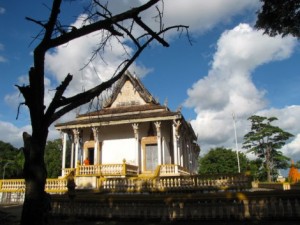
Front side of the Wat Baray Choan Daek Pagoda in Kampong Thom today (picture via this blog)
Mr. De Wilde moved on to ask Meas Layhuor if she knew where the Wat Baray Choan Dek Pagoda was.
“Wat Baray Choan Dek Pagodais located right in my village. It was a killing site,” Ms. Meas affirmed. She would pass by it every tenth day, the day when they would be given dessert and allowed to return to their villages:
“One day I came by [the pagoda] when music was being played. Two soldiers came by and threatened me with their guns and told me not to trespass. I later learned that when loudspeakers were playing music, it meant people were being killed. I trembled with fear and never came close to it again.”
Defense counsel for both Khieu Samphan and Nuon Chea strenuously objected to this line of questioning advancing that the pagoda was not part of the trial or of this segment. They argued that there was no causal link between the pagoda and the 1st January Dam site, the focus in this part of the case. Further, the pagoda was not a security site as determined by the Closing Order. They advised that there were only three security sites in this part of the trial, and that the pagoda is not one of them.
“It is pointless, it is a waste of time, and it is out of the scope of this trial,” Mr. Koppe said.
Mr. de Wilde retorted that, if his colleagues on the opposing side had bothered to read the Closing Order, they would have seen that the pagoda is included as part of the 1st January Dam section because it was there that the people working on the dam were executed.
The objection overruled, Ms. Meas responded that she could clearly see the pagoda from the 1st January Dam.
“All those who were taken to the pagoda were executed,” she continued. “About four or five people in my team were taken to the security prison including Tree. Tree was stubborn. He protested about the amount of food and refused to perform labor, and was arrested by Angkar.” After that, Ms. Meas said, no one else dared to protest about food: “We were working very hard because we were afraid of being killed.”
Cham people
“There were no Cham in my team, “Meas Layhuor remembered. “But I saw Cham in other groups. They did not let them practice their religion. If they saw them practicing Islam, they would be taken away and killed. They were not allowed to speak their language either.” And the Cham had to eat pork: “Everyone was instructed to eat pork. No one could refuse. And if we did not eat, we had nothing to eat so we had to eat pork anyway.”
Ms. Meas was not allowed to choose her work, the workers went where they were assigned or they would be taken away to be reeducated and their meals take away. They “could not refuse the instruction of Angkar.” There was no salary for all their hard work as there was no money in use then. They were “happy to have meals to eat.” They were not free to meet with their colleagues. “Only the elderly and the children were free. (She) worked until the regime fell.” She could not make any contact with the male workers. If they happened to chat, the two miscreants “would be assigned to dig the termite mines far away.”
The hearing will resume tomorrow with defense examinations of Meas Layhuor.
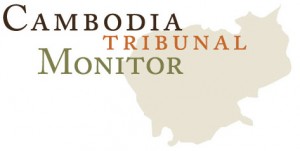
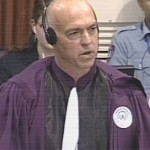
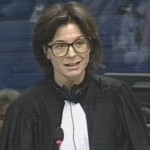
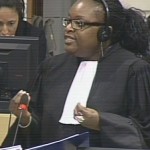
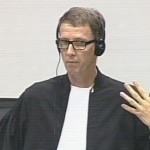
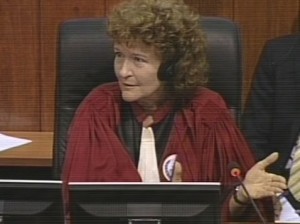
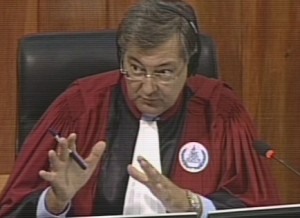
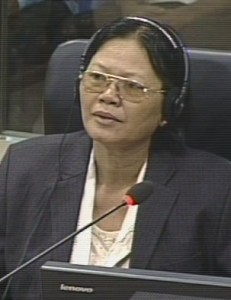
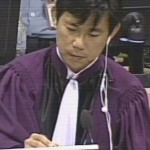
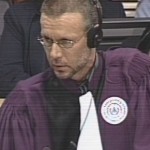
[…] The day started off with a meaningful and theatrical exchange between Victor Koppe, defense counsel for Nuon Chea, and Judge Lavergne. The exchange at its core was on the still pending decision of how the Chamber will allow torture tainted confessions. (You can read a summary of the oral argument on this matter before this Chamber here.) […]
[…] may have been tainted by torture (see a summary of oral arguments on this matter by yours truly here) but he wanted to understand Mr. Loeur’s […]